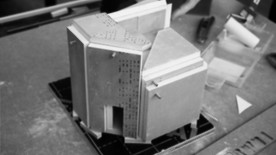
Lamineringsmaterials styvhet och fuktrespons. En undersökning med Rosenborg slott som fallstudie
Den här uppsatsen är en undersökning av lamineringsmaterials styvhet och fuktrespons. Syftet är dels att undersöka om lamineringarnas preventiva aspekt kan förstärkas med hjälp av styva och fukttåliga inskott; och dels att undersöka vilka material som lämpar sig bäst att använda till laminering av målningar som hänger i klimat med fluktuerande relativ fuktighet. Av den anledningen används Rosenborg slott i Köpenhamn som fallstudie, och laminatens fuktrespons testas i fluktuerande RF som efterliknar det som uppmätts på Rosenborg slott. Styvheten testas i dragprovstest. Som stöddukar testas linneduk, Polyflax och polyestersegelduk, och som inskott testas Hollytex och polyestersegelduk. Beva 371-film används som häftmedel.
Resultatet visade att inskotten inte har någon nämnvärd inverkan på laminatens fuktrespons, utan att det framför allt är stöddukarna som kan dämpa målningens reaktioner. Den stödduk som dämpade fuktresponsen mest var polyestersegelduk. Polyestersegelduk visade också störst styvhet och minst spänningsavlsappning. Linneduk gav mest fuktrespons, var minst styvt och hade låg isotropi. Båda typer av inskott ökade styvheten och minskade spänningsavslappningen, men gav olika resultat i fråga om isotropi.
Vid laminering av målningar i historiska hus rekommenderas att använda styva inskott, tillsammans med polyestersegelduk som stödduk. Av de testade materialen ger detta den minsta belastningen på målningen, och gör att målningen kan bibehålla spänning efter exponering för fluktuerande RF. Därmed kan det ge ett mer långsiktigt skydd för målningar i miljöer med okontrollerat klimat.
Nyckelord
styvhet, fuktrespons, laminering, Rosenborg slott, relativ fuktighet
Abstract
This thesis is a study of the stiffness and moisture response of materials for nap bond lining. The aim is to examine whether the preventive aspect of nap bond linings can be enhanced by the use of stiff and non-hygroscopic inserts; and to examine which materials are best suited for nap bond lining treatments of canvas paintings, exposed to fluctuating RH. Rosenborg Castle in Copenhagen is used as a case study, and the moisture response of the laminate samples are tested in a fluctuating RH that emulates the RH of Rosenborg Castle. The stiffness is tested in tensile tests. Linen canvas, Polyflax and polyester sailcloth are tested as lining canvases, and Hollytex and polyester sailcloth are tested as inserts. Beva 371-film is used as a lining adhesive.
The results showed that the inserts did not have any significant impact on the laminate moisture response, but that it is mainly the lining canvases that mitigate the painting’s moisture response. Among the lining canvases, polyester sailcloth could mitigate the painting’s moisture response most efficiently. Polyester sailcloth also had the greatest stiffness and the lowest stress relaxation. Linen canvas showed the greatest moisture response, the least stiffness, and the lowest isotropy. Both types of inserts increased stiffness and reduced stress relaxation, but gave different results in terms of isotropy.
When nap bond lining canvas paintings in historic houses, it is recommended to use stiff inserts together with polyester sailcloth as a lining canvas. This reduces the load on the painting the most, and allows the painting to retain tension after being exposed to fluctuating RH. Thus, it can provide a more long-term protection of canvas paintings housed in environments without climate control.
Keywords
stiffness, moisture response, nap bond lining, Rosenborg Castle, relative humidity













